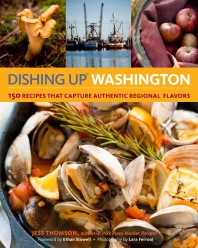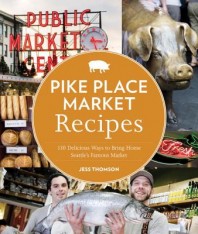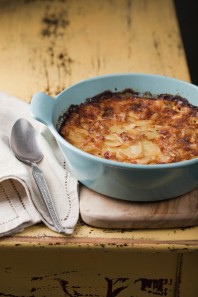 The day I decided to write Dishing Up Washington, a cookbook that celebrates the state’s foodways through recipes and stories, I went to my neighborhood farmers’ market. It’s on Seattle’s Phinney Ridge, in the northern part of the city, near the giant windmill sign that keeps watch over the city’s famous Red Mill Burgers.
The day I decided to write Dishing Up Washington, a cookbook that celebrates the state’s foodways through recipes and stories, I went to my neighborhood farmers’ market. It’s on Seattle’s Phinney Ridge, in the northern part of the city, near the giant windmill sign that keeps watch over the city’s famous Red Mill Burgers.
From the top of the hill, I saw a panorama of what makes Washington food fantastic–that bustling farmers’ market in the foreground, and behind it, the mountains that sawtooth south toward Mt. Rainier, beyond which the state’s growing conditions are perfect for fruit, foraging and winemaking. Turning around, I could see the Ballard Locks, where fishing vessels coming home from trips up Puget Sound and along the coast patiently wait their turn to unload salmon, halibut, crab and spot prawns. It sunk in that after settling in Washington only five years earlier, after spending my childhood in Idaho and my twenties in New England, I’d found home. I’d found a place I never want to leave.
 I hoped Dishing Up Washington could be a compendium of things that, taken together, represent the state’s food scene and what I love about it. I wanted recipes from the state’s best restaurants. That part was easy enough; between Seattle and the blossoming craft food scenes in cities like Bellingham, Yakima, Wenatchee, and Walla Walla, I knew I’d have a book full of enticing restaurant-style recipes that folks could recreate in their own kitchens. I tested and tasted, tinkered and retested, until I had half a book’s worth of mouthwatering favorites–things like homey meatballs from Seattle’s Rain Shadow Meats and Picnic’s Kale Salad, both of which will forever be winter staples for me. Things like Madison Park Cafe’s roasted game hens, which are fancy enough to turn dinner into a celebration but easy enough to approach on a weeknight.
I hoped Dishing Up Washington could be a compendium of things that, taken together, represent the state’s food scene and what I love about it. I wanted recipes from the state’s best restaurants. That part was easy enough; between Seattle and the blossoming craft food scenes in cities like Bellingham, Yakima, Wenatchee, and Walla Walla, I knew I’d have a book full of enticing restaurant-style recipes that folks could recreate in their own kitchens. I tested and tasted, tinkered and retested, until I had half a book’s worth of mouthwatering favorites–things like homey meatballs from Seattle’s Rain Shadow Meats and Picnic’s Kale Salad, both of which will forever be winter staples for me. Things like Madison Park Cafe’s roasted game hens, which are fancy enough to turn dinner into a celebration but easy enough to approach on a weeknight.
The other half of that book, though–that was the challenging part. The other half was meant to be recipes inspired by raw ingredients, things like mushrooms and crab and goat cheese and saffron, things our state produces (yes, saffron grows well on the Olympic Peninsula!). I had overflowing handfuls of ideas. I had counters full of produce for months. I’d had plenty of experience developing  recipes and writing cookbooks, but I felt almost intimidated by the responsibility of doing the very best things with certain ingredients–because, often, those ingredients really are best all on their own.
recipes and writing cookbooks, but I felt almost intimidated by the responsibility of doing the very best things with certain ingredients–because, often, those ingredients really are best all on their own.
Take Dinah’s Cheese, a glorious Camembert-style cow’s milk cheese made on Vashon Island: It’s gooey cheese. It doesn’t need anything but a mouth and an eye roll to be enjoyed properly. But any book about Washington would be incomplete without its mention, so I found a way to incorporate it into a real recipe. It turns out that Dinah’s Cheese makes a potato gratin almost indecently delicious and creamy. Ditto for the state’s gorgeous spot prawns, which are delicious simply boiled or grilled but also great with a curried caramel dipping sauce, or Ballard Bee Company’s amber honey, which adds the perfect sweetness to cottage cheese pancakes or honeyed panna cottas but is actually best, frankly, eaten off a spoon.
In the end, it’s a challenge I happily accepted–and one you’ll enjoy tasting, I think.
Jess Thomson is a food writer based in Seattle and was recently named “one of seven writers you should know” by the Chicago Tribune. She’s the author of Dishing Up Washington: 150 Recipes That Capture Authentic Regional Flavors and Pike Place Market Recipes: 130 Delicious Ways to Bring Home Seattle’s Famous Market, and her work regularly appears in Sunset and Edible Seattle. She writes about food and life on her blog and is a regular guest on Seattle’s NPR station, KUOW.
Thomson will appear at 7 pm today (Saturday the 10th) at Village Books‘ Book Fare Cafe and at 4 pm on Monday, Nov. 12 at Watermark Book Company in Anacortes, WA. Word has it she’ll be serving up some treats!
Here’s Thomson’s recipe for potato gratin, excerpted from Dishing Up Washington (c) Jess Thomson. Photo (c) by Lara Ferroni. Excerpted with permission of Storey Publishing.
Potato Gratin with Dinah’s Cheese and Pancetta
 At Vashon Island’s Kurtwood Farms, owner Kurt Timmermeister makes a bloomy-rind cow’s milk cheese called Dinah’s Cheese. When it was first released in 2009, Seattle swooned; nowhere in the state is there a farmstead Camembert-style cheese so clearly fit for international fame. In my official opinion, it would be an atrocity to do anything to Dinah’s Cheese besides eat it at room temperature at its peak ripeness, when the middle succumbs to a thumb’s soft pressure and the inside has the consistency of thick homemade pudding. But should your path cross a certain gooey cheese good enough to make you voluntarily lie prostrate in a busy street, and you promise not to tell anyone that you’d consider putting half a wheel into a simple potato gratin with little bits of pancetta and a glug of cream, read on. This is just the right way to do the wrong thing.
At Vashon Island’s Kurtwood Farms, owner Kurt Timmermeister makes a bloomy-rind cow’s milk cheese called Dinah’s Cheese. When it was first released in 2009, Seattle swooned; nowhere in the state is there a farmstead Camembert-style cheese so clearly fit for international fame. In my official opinion, it would be an atrocity to do anything to Dinah’s Cheese besides eat it at room temperature at its peak ripeness, when the middle succumbs to a thumb’s soft pressure and the inside has the consistency of thick homemade pudding. But should your path cross a certain gooey cheese good enough to make you voluntarily lie prostrate in a busy street, and you promise not to tell anyone that you’d consider putting half a wheel into a simple potato gratin with little bits of pancetta and a glug of cream, read on. This is just the right way to do the wrong thing.
2 teaspoons extra-virgin olive oil
¾ cup (about 3 ounces) diced pancetta
4 medium Yukon Gold potatoes (about 2 pounds), peeled and sliced 1/8 inch thick
3 tablespoons unbleached all-purpose flour
Salt
Freshly ground black pepper
4 ounces not-quite-ripe Camembert–style cheese (about ½ wheel), chilled
2⁄3 cup heavy cream
½ cup whole milk
1 egg
8 servings
1. Preheat the oven to 350°F. Coat an 8- by 8-inch (or similar) gratin dish with the oil and set aside.
2. Heat a medium skillet over medium heat. Add the pancetta, and cook, stirring occasionally, until crisp, 6 to 8 minutes. Set aside.
3. Meanwhile, toss the potato slices and flour in a large bowl, using your hands to distribute the flour evenly. Season the potatoes with salt and pepper (the amount of salt you use should depend on how salty your pancetta tastes). Cut the cheese into thin slices. (You can leave the rind on.)
4. Spread one-third of the potatoes along the bottom of the dish, overlapping them as necessary. Scatter one-third of the cooked pancetta over the potatoes, followed by one-third of the cheese, broken up into little bits. Repeat with the remaining ingredients, making two more layers, ending with pancetta and cheese. Whisk the cream, milk, and egg together in a small bowl, then carefully pour the liquid mixture over the potatoes.
5. Cover the gratin tightly with aluminum foil and bake for 30 minutes. Remove the foil, increase the temperature to 400°F, and bake 40 to 45 minutes longer, or until the potatoes are lightly browned on top and a skewer can pierce through the layers easily. Let cool for 10 to 15 minutes before serving.


